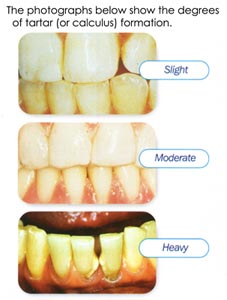How can I reduce plaque and tartar buildup?
 Plaque
is a sticky, colorless deposit of bacteria that is constantly forming on the
tooth surface. Saliva, food, and fluids combine to produce these deposits that
collect on teeth and where teeth and gums meet.
Plaque
is a sticky, colorless deposit of bacteria that is constantly forming on the
tooth surface. Saliva, food, and fluids combine to produce these deposits that
collect on teeth and where teeth and gums meet.
The buildup of plaque can trap stains on the teeth, and it is also the
primary factor in periodontal (gum) disease. Fighting plaque is a life-long part
of good oral care.
Plaque begins forming on teeth 4 to 12 hours after brushing, which is why it
is so important to brush at least twice a day and floss daily.
Tartar, also called calculus, is a crusty deposit that can trap stains on the
teeth and cause discoloration. It creates a strong bond that can only be removed
by a dental professional. Tartar formation may also make it more difficult to
remove new plaque and bacteria.
Individuals vary greatly in their susceptibility to plaque and tartar. For
many of us, these deposits build up faster as we age.
Understanding Calculus
Calcium and phosphate bind to form crystals on the teeth. These calcium
phosphate crystals eventually harden within plaque, forming calculus. Certain
types of chemicals called pyrophosphates help to decrease calculus buildup by
stopping the growth of crystals on the tooth surface and preventing new crystals
from forming.